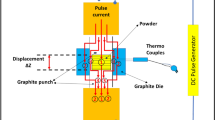The paper analyzes the sintering of three types of calcium phosphate powders and S–B–Na glass powder under the same conditions. It is concluded that a liquid phase, represented by the glass melt, shows up when the glass is sintered with biogenic or synthetic hydroxyapatite or a mixture of synthetic phosphates. The substantial pore formation in the sintering process is mainly due to the removal of carbon oxides and water vapors resulting from glass charge decomposition and glass boiling. Parameters of grain and porous microstructures of the ceramics are shown before and after the primary and secondary sintering. The mechanical strength and biosolubility of the ceramic samples are reported as well.

Similar content being viewed by others
References
R. Z. LeGeros, J. P. LeGeros, G. Daculsi, and R. Kijkowska, “Calcium phosphate biomaterials: preparation, properties and biodegradation,” in: Encyclopedic Handbook of Biomaterials and Bioengineering, Marcel Dekker Inc., New York (1995), pp. 1429–1463.
A. Afonso, J. D. Santos, M. Vasconselos, and R. Branco, “Granules of osteoapatite and glass-reinforced hydroxyapatite implanted in rabbit tibiae,” J. Mater. Sci. Mater. Med., No. 7, 507–510 (1996).
M. A. Mal’kov, S. V. Lipochkin, Yu. M. Mosin, and L. N. Pimneva, “Hydroxyapatite ceramics for medical purposes,” Steklo Keram., No. 7, 28–29 (1991).
N. D. Pinchuk and L. A. Ivanchenko, “Making calcium phosphate biomaterials,” Powder Metall. Met. Ceram., 42, No. 7–8, 357–371 (2003).
К. Carlson, “The biological activity of glass and its relationship to structure,” Fiz. Khim. Stekla, 24, No. 3, 405–412 (1998).
L. A. Ivanchenko, T. I. Fal’kovskaya, N. D. Pinchuk, et al., “Preparation and properties of hydroxyapatite strengthened with a glass phase,” Powder Metall. Met. Ceram., 42, No. 1–2, 54–59 (2003).
L. A. Ivanchenko, N. D. Pinchuk, A. A. Krupa, et al., “Structure and properties of a hydroxyapatite-based composite,” Steklo Keram., No. 6, 30–31 (2003).
V. V. Skorokhod, L. A. Ivanchenko, and N. D. Pinchuk, “Porosity and bioactivity of hydroxyapatite-glass composites,” Funct. Mater., 13, Issue 7, No. 2, 260–264 (2006).
O. Sych, N. Pinchuk, A. Parkhomey, et al., “Morphology structure and properties of new porous biocomposites based on biogenic hydroxyapatite and synthetic calcium phosphates,” Funct. Mater., 14, No. 4, 430–435 (2007).
E. E. Sych, N. D. Pinchuk, L. A. Ivanchenko, et al., “Studying the properties of composites based on synthetic nanosized hydroxyapatite,” in: Current Challenges of Material Physics. Series: Physics and Chemistry of Powder Material Technology (Collected Papers) [in Russian], Issue 18, Inst. Probl. Materialoved. NAN Ukrainy, Kiev (2009), pp. 115–120.
E. E. Sych, N. D. Pinchuk, L. A. Ivanchenko, et al., “Nano- and microsized systems in composite biomaterials based on hydroxyapatite,” in: Nanosystems, Nanomaterials, and Nanotechnologies (Collected Scientific Papers) [in Ukrainian], Vol. 7, No. 1, Inst. Metallofiz. NAN Ukrainy, Kiev (2009), pp. 263–269.
E. E. Sych, N. D. Pinchuk, and L. A. Ivanchenko, “Effect of sintering temperature on the properties of biogenic hydroxyapatite–glass composites,” Powder Metall. Met. Ceram., 49, No. 3–4, 153–158 (2010).
N. D. Pinchuk, L. A. Ivanchenko, and E. E. Sych, “Studying the pore formation and volume changes in liquid-phase sintering of hydroxyapatite–glass composites,” in: Nanosystems, Nanomaterials, and Nanotechnologies (Collected Scientific Papers) [in Ukrainian], Vol. 7, No. 2, Inst. Metallofiz. NAN Ukrainy, Kiev (2009), pp. 589–594.
V. V. Skorokhod and S. M. Solonin, Physical Metallurgy of Powder Sintering [in Russian], Metallurgiya, Moscow (1984), p. 160.
D. C. Tancred, B. A. O. McCormack, and A. J. Carr, “A quantitative study of the sintering and mechanical properties of hydroxyapatite/phosphate glass composites,” Biomaterials, 19, Issue 19, 1734–1743 (1998).
E. E. Sych, Evolution of the Structure and Properties of Calcium Phosphate Materials Produced by Liquid-Phase Sintering [in Ukrainian], Author’s Abstract of PhD Thesis, Kiev (2010), p. 29.
S. N. Danilchenko, A. V. Koropov, and I. Y. Protsenko, “Thermal behavior of biogenic apatite crystals in bone: an x-ray diffraction study,” Cryst. Res. Technol., 41, No. 3, 268–275 (2006).
D. L. Mastryukova, B. I. Beletskii, and O. V. Polukhina, “Glass ceramics with controlled pore microstructure for medicine,” Steklo Keram., No. 4, 23–26 (2007).
Author information
Authors and Affiliations
Corresponding author
Additional information
Translated from Poroshkovaya Metallurgiya, Vol. 51, No. 3–4 (484), pp. 50–58, 2012.
Rights and permissions
About this article
Cite this article
Ivanchenko, L.A. Sintering of different hydroxyapatite powders and low-melting sodium borosilicate glass. Powder Metall Met Ceram 51, 165–171 (2012). https://doi.org/10.1007/s11106-012-9412-7
Received:
Published:
Issue Date:
DOI: https://doi.org/10.1007/s11106-012-9412-7




